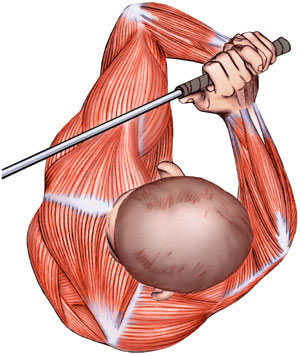Physiotherapy Golf Press – What To Expect With Shoulder Surgery And Recovery
By Brandon Schomberg
This article will touch on the structure of the shoulder joint, related pathologies, as well as a few common surgical procedures and associated recovery expectations and timelines. I have included two of Twin Cities Orthopedics (TCO) top surgeons that specialize in shoulder conditions, Dr. Frank Norberg, and Dr. Gregory Lervick.
First, we should discuss the anatomy of the shoulder joint (glenohumeral joint), which is the most mobile joint in the body allowing tremendous motion. It is known as a ball and socket joint. The shoulder consists of three bones, the humerus (upper arm bone, the top part of this is the ball), the scapula (shoulder blade), as well as the clavicle (collarbone). The glenoid acts like a shallow cavity, the socket, in the most lateral aspect of the scapula. The glenoid with the humerus makes up the glenohumeral joint. Together, these bones along with the connected musculature, ligamentous attachments, capsule, and tendons provide stability and mobility of the shoulder. Due to this complexity, the shoulder is vulnerable to many various types of injuries. In addition to displaying this wide range of movement, there must be sufficient stability in the shoulder to handle the stress in the various movements. Varying ages of the golfer will typically manifest different pathologies.
In order to understand the varying pathologies that can occur, lets look at the types of cartilage within the shoulder joint. There is articular cartilage, which covers the end of our bones to allow ideal gliding between the bones. If however, there is wear and tear from excessive imbalances, which is more commonly observed in the older seasoned golfers, this can lead to degenerative changes (osteoarthritis) in this cartilage inside the shoulder. Loss of the cartilage will result in structural changes to the bones. These symptoms may present as a constant or intermittent achiness, stiffness, and pain with sleeping, or daily use of the shoulder. As time progresses, gradually range of motion is decreased, and pain will generally increase. At this point, if the pain is severe enough or your quality of life and golf related movement is affected, then you may be heading down the path of a total or reverse shoulder replacement. Following a total shoulder replacement surgery, the damaged parts of the shoulder ball and socket are replaced with a metal ball attached to a stem, and a plastic socket similar to original anatomy of the shoulder. A reverse total shoulder replacement is typically reserved for individuals with more damaged rotator cuff tendons or previous failed shoulder replacement. There will be specific restrictions depending on the surgical procedure. Patients can expect to be in a sling for 3-4 weeks. Specific physical therapy instructions will be based on your surgical approach and physical exam. Following a total shoulder replacement, the average time for returning to a full round of golf is 3-5 months. Golfers can start swinging slowly at 8 weeks if your treating golf physical therapist and surgeon are in agreement. Discussions of restrictions are taken into account and can be individually based between the sports medicine team.
For the middle-aged golfer, it is more common to see damage to the rotator cuff musculature that progressively increases in pain. I am sure many of you have had a fellow golfer complain about a dull ache in the shoulder that will often increase with sleeping or using the shoulder repeatedly. What happens is that the rotator cuff, a group of four muscles and tendons that run from the shoulder blade to the shoulder joint, becomes irritable, inflamed, weakened, or in the worst-case scenario, various size tears can occur in the muscle or tendon. The rotator cuffs muscles work together by providing support to allow the head of the upper arm bone to remain securely within the shallow socket of the shoulder. As athletes age, the risk of rotator cuff injury also increases. The good news is that research demonstrates that those with higher risk occupations, or even those displaying some symptoms, can fully recover with a individually based physical therapy program to suit your golf and occupation needs. A short period or rest along with appropriately prescribed exercises can allow you to safely heal, and return to golf more quickly, even if there is a small tear. Pay attention to your body, and in the event of any pain, achiness, swelling, weakness or general fatigue, consultation with a golf specific physical therapist to address these concerns is highly recommended. More severe rotator cuff injuries, involving complete tears of the muscle or tendon will likely require surgical repair.
There are various shoulder techniques used to repair a rotator cuff. Most commonly, an arthroscopy is performed through several small incisions to view the inside of the shoulder and allow insertion of instruments to assist in the repair process. A mini-open repair will often allow decompression of bone spurs that may have contributed to the damage tissue. The discussion on which is a better option for you will be decided by you and your shoulder surgeon. Through each surgical process, the repair of the rotator cuff is performed, as the tendons are re-attached to the bone through suture anchors. The rehabilitation process will vary depending on the surgical process and your age, but your golf therapist will guide you safely through each phase to get you back playing golf pain free. In general, you can expect to be in a sling for 4-6 weeks, with specific motions initiated and directed by your golf physical therapist. Golfers with small to medium rotator cuff repairs may return sooner than those with large to massive rotator cuff repairs.



